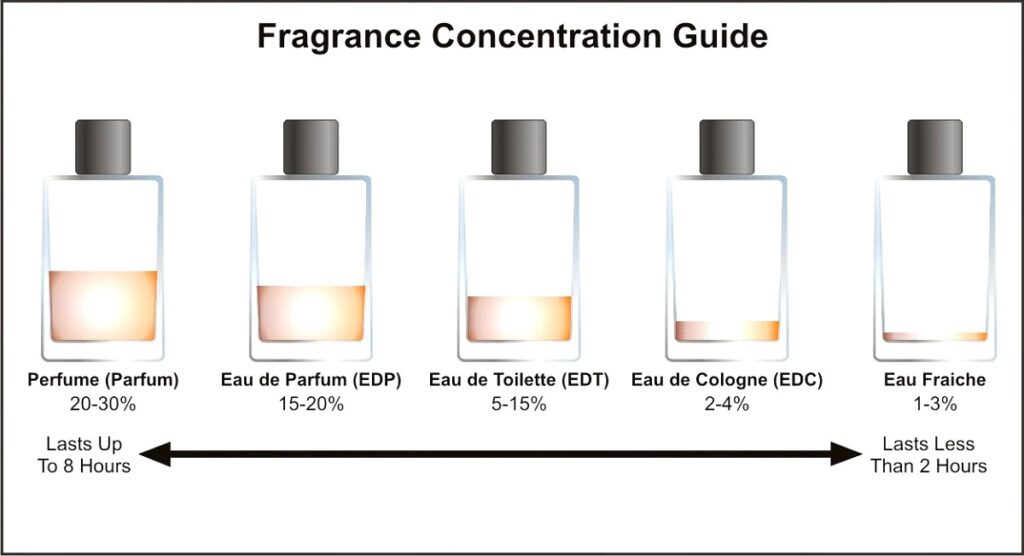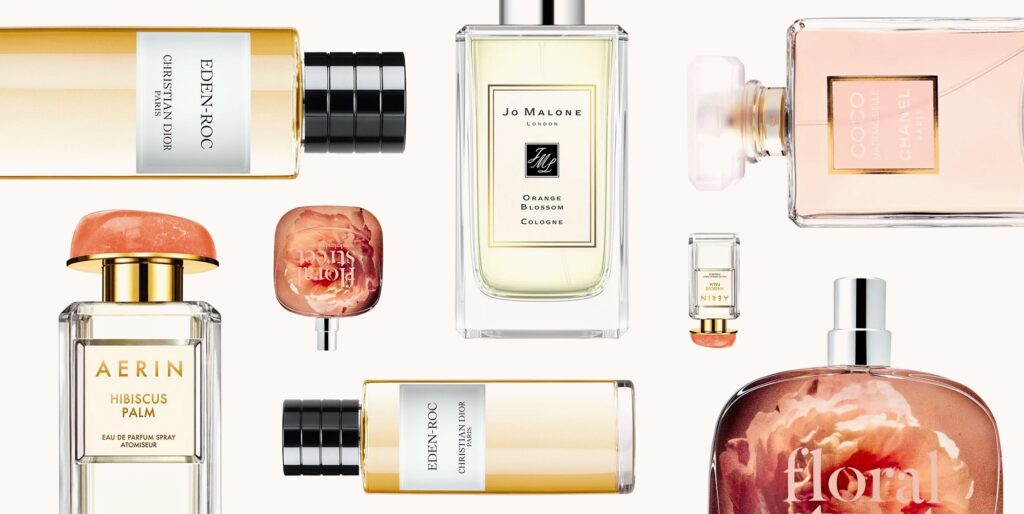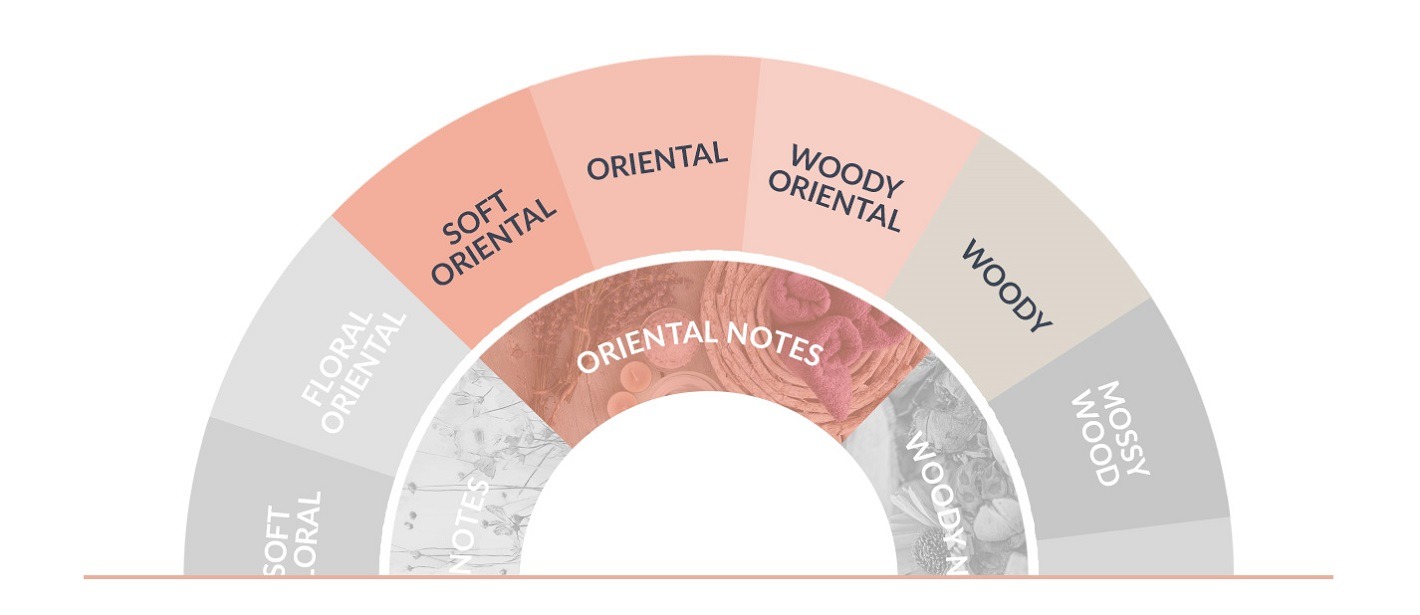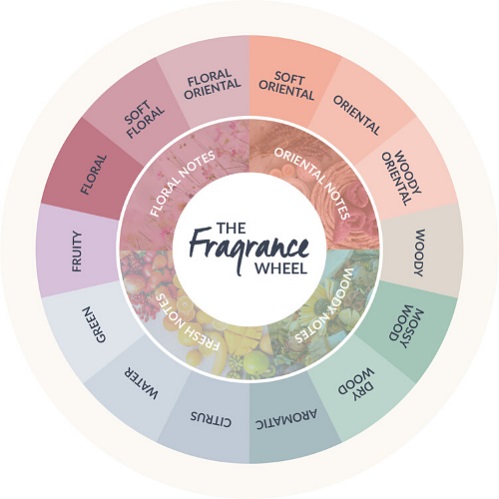Dive into the captivating world of fragrance families. Discover the unique characteristics that define each aromatic category. From floral and oriental to citrus and woody, embark on a journey of olfactory exploration with us.
Discovering the perfect scent for you can be quite a task. But don’t worry, before you pick a perfume, it’s good to know about fragrance families. Explore our handy guide to scent strengths and types, coupled with our fragrance wheel.
Let me ask you a question, have you ever found yourself standing before an array of perfume bottles, feeling a tad bewildered by the sheer variety of scents on display?
If you have, don’t stress! – We are here to help!
Let’s take a fun journey into the world of fragrance families. We’ll break down the mysterious language of scents and find the right perfume for any mood.
Understanding Fragrance Notes
Before we start exploring fragrance families, let’s understand fragrance notes. Think of it like creating music – same as musicians, perfumers make perfumes by mixing top, middle, and base notes together. This creates a scent that changes over time, just like a song with different parts.
- Top Notes: Imagine a curtain rising on a theatrical performance – that’s what top notes do for a fragrance. These are the initial scents that greet your senses, often with a burst of freshness and brightness. Citrus fruits like bergamot, lemon, and mandarin are common top notes, along with herbal elements like lavender and mint. These notes are fleeting, setting the stage for what’s to come.
- Middle Notes (Heart Notes): As the top notes gracefully exit, the middle notes take centre stage. These form the heart of the fragrance, providing depth and character. Floral and fruity notes often shine in this layer – think of roses, jasmine, and geranium. Flavors like cinnamon and nutmeg bring a warm and intricate touch to my mix. As time passes, the middle notes stay around, unveiling the genuine soul of the fragrance.
- Base Notes: Wrapping it up are the Base Notes: a splendid conclusion reserved for them, infusing the scent with long-lasting allure and richness. These notes secure the arrangement, transforming gradually throughout hours, thus forming the very essence on which the aroma is built. Rich woods like sandalwood and cedar, as well as warm resins like benzoin and myrrh, create a sense of comfort and sensuality. Base notes are the lingering memory that stays with you throughout the day.

What is the Difference between Eau de Parfum (EDP), Eau de Toilette (EDT), and Eau de Cologne?
So, now that we’ve taken a little journey through the fascinating landscape of scent notes and families, it’s time to roll up our sleeves and really get into the nitty-gritty of perfume concentrations.
- Eau de Cologne: Imagine a refreshing morning breeze waking up your senses – that’s Eau de Cologne. It’s got the lightest amount of scent stuff, usually around 2-5%. Eau de Cologne feels invigorating and lively, perfect for a quick pick-me-up or a soft, daytime vibe. Because it’s not super strong, it doesn’t stick around for ages, which suits me ’cause I like reapplying scents during the day.
- Eau de Toilette (EDT): Eau de Toilette strikes a great balance between freshness and a lasting smell. It’s got more scent stuff in it, around 5-15%. This gives it a stronger and longer-lasting smell compared to Eau de Cologne. I go for EDT when I want a scent that’s with me through the day, adding a nice touch to different activities.
- Eau de Parfum (EDP): If I’m in the mood for a powerful and lasting scent, I pick Eau de Parfum (EDP). It’s got even more scent stuff, about 15-20%. EDP gives me a rich and intricate smell that stays around for a while. I can enjoy it all day with just a couple of sprays. EDP works for me whether it’s daytime or evening – it’s pretty versatile.
What Exactly is the Fragrance Wheel?
Alright, as we continue our journey into the captivating realm of perfumery, let me introduce you to a little something that acts like a guiding star in this constellation of scents – the fragrance wheel. Think of it as a trusty map that helps us navigate through the complex universe of aromas. Imagine a colour wheel that categorizes shades and hues; similarly, the fragrance wheel categorizes perfumes based on their predominant scent characteristics.
We asked Perfume Expert Raymond King the following question – How does the fragrance wheel work?
The fragrance wheel is divided into four main categories, each representing a primary scent family: Floral, Oriental, Woody, and Fresh. These main groups are then split into smaller groups, making a complete picture of all the different smells you can find in perfumes.For instance, within the Floral family, you’ll find subcategories like Floral Oriental, Soft Floral, and Floral Woody, each capturing unique aspects of the floral spectrum. Think of the fragrance wheel like a guide that points you in the right direction. It’s like having a scent compass that not only leads you to the aromas you adore but also surprises you with unfamiliar ones that spark joy.
Let’s Dive into Perfume Scents: A Quick Guide
As we dig into each fragrance family, we uncover loads of scents that bring up all sorts of feelings and memories.
In the Floral family, you’ll encounter the elegance of roses, the whimsy of violets, and the purity of lilies. The Oriental clan beckons, tempting you into a realm drenched in mysterious spices – cinnamon and cloves dance in a perplexing concoction, while vanilla and amber cast an enchanting spell you can’t quite fathom.
As for the Woody crew, they’re like a riddle wrapped in earthiness – patchouli teases with an enigmatic allure, sandalwood exudes a warmth that leaves you questioning, and pine adds a dash of bewildering freshness.
Then come the Citrus virtuosos, oh-so tantalizing yet puzzling – the tang of lemon hits you like a riddle’s punchline, orange blossom whispers secrets of sweet allure, and bergamot delivers a crispness that’s like a conundrum unfolding on your skin.

Examples of Popular Perfumes from Each Fragrance Family
Now that we’ve navigated the perfume scents guide, explored fragrance notes, delved into concentration differences, and introduced the fragrance wheel, let’s highlight a few iconic perfumes that belong to each fragrance family:
- Floral: Chanel’s Coco Mademoiselle, Viktor & Rolf’s Flowerbomb
- Oriental: Dior’s Hypnotic Poison, Guerlain’s Shalimar
- Woody: Creed’s Green Irish Tweed, Maison Francis Kurkdjian’s Baccarat Rouge 540
- Citrus: Jo Malone’s Lime Basil & Mandarin, Atelier Cologne’s Orange Sanguine
So what now?
Understanding fragrance families, notes, concentrations, and the fragrance wheel can be complex. However, gaining this knowledge is key to finding the perfect scent that suits your style. It’s like embarking on a journey where your senses guide you through a diverse world of fragrances.
Get ready to explore fragrance families and notes, unraveling the mysteries of scents and embracing your fragrant destiny with confidence.


